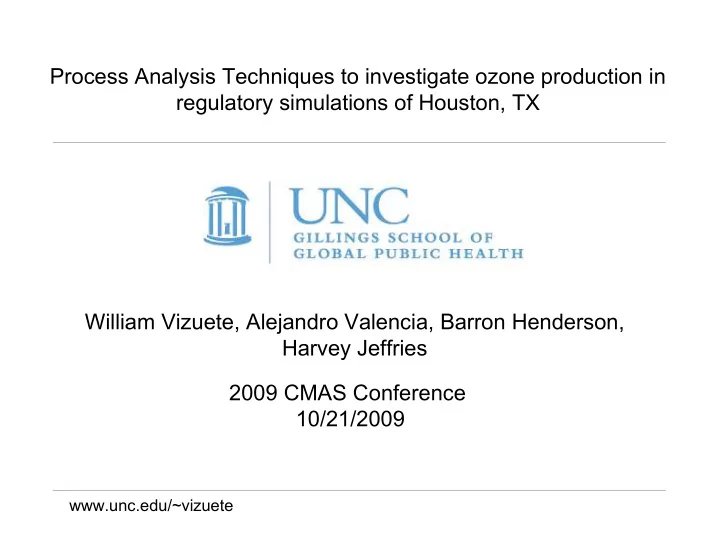

Process Analysis Techniques to investigate ozone production in regulatory simulations of Houston, TX William Vizuete, Alejandro Valencia, Barron Henderson, Harvey Jeffries 2009 CMAS Conference 10/21/2009 www.unc.edu/~vizuete
Planetary Boundary Layer (PBL)
Planetary Boundary Layer (PBL) How is model predicted O 3 sensitive to variability in the rate of rise of the Planetary Boundary Layer?
Outline Modeling Datasets Results Conclusions Future work 4
Houston,TX is a Non-attainment Area for 8-hr O3 (85 ppb) 5
Modeling Dataset The Texas Commission of Environmental Quality (TCEQ) CAMx Air Quality Model Simulations 2000 Episode 21 modeling days 2005/2006 Episodes 120 modeling days 6
Outline Modeling Datasets Results Conclusions Future work 7
Simulated PBL •CAMx: Found by extracting vertical mixing parameter (k v ) and calculating PBL • Calculation made using same algorithm as ENVIRON’s VERTAVG* *Page 9-14 CAMx users guide 8
Focus on Central Houston 9 1,250 km 2
“Slow Riser” August 1, 2005 1- Hour O 3 144 ppb “Fast Riser” August 6, 2005 1- Hour O 3 124 ppb 9 am 10
Fast Riser higher than Slow Riser 7 am “Slow Riser” August 1, 2005 9 LST “Fast Riser” August 6, 2005 9 LST 11
2 Distinct PBL Rises Slow Riser = PBL change less than 700 m/h between 6 to 11 LST Fast Riser = PBL change more than 700 m/h between 6 to 11 LST 12
Morning PBL Rise •2000: •Slow riser PBL on high ozone days •2005/2006 • 63 modeling days with 8-hr Max O3 >85 ppb • 35% had a fast morning rise in PBL •How were model processes changed?
Process Analysis Results Model Evaluation and Analysis Poster Session 10/20/2009 Python-based Environment for Reaction Mechanisms (PERM) Barron Henderson https://dawes.sph.unc.edu/trac/PERM
Process Analysis Aggregation: Vertical Time 15
Process Analysis Aggregation: Horizontal 16 1,250 km 2
Model Experiment 2 New-modeled days Emission Meteorology (PBL Inventory Rise) Weekday Slow Weekday Fast 17
2 Meteorological Days Slow Riser Fast Riser 18
Physical Processes : O3 06/21/05 Weekday Slow Riser Fast Riser 19
Physical Processes : NOx 06/21/05 Weekday Slow Riser Fast Riser 20
Physical Processes : VOC 06/21/05 Weekday Slow Riser Fast Riser 21
Chemical Processes •Aggregated for photochemical day •Sources of new OH radicals virtually the same •Shift of OH reactions from OH+NO2 to OH+VOC in PBL FAST •Shift of OH+VOC to slower reacting species in PBL FAST •Production of late afternoon H2O2 production in PBL FAST
Fast Riser NOx-limited Earlier, Longer Weekday - P( H 2 O 2 ) : P(HNO 3 ) NOx-limited NOx-inhibited 23 HO 2 + HO 2 H 2 O 2 + O 2 OH + NO 2 HNO 3
Summary and Conclusion Fast Riser vs. Slow Riser Entrainment of VOCs that bring in new VOCs 5x more Dilution of NOx and VOCs Steeper O3 production rate NOx-limited much earlier in day than Slow Riser Lower & Earlier Peak O3 Same set of EI show distinct O3 producing regimes Affect the type of controls needed to reduce O3 24
Future Work Compare Slow Riser and Fast Riser phenomena with Observed data. Evaluation of ACM2 mixing scheme in Houston Acknowledgements This project was funded by the Houston Advanced Research Center (HARC) under Project H97. www.harc.edu Thanks to TCEQ for providing data and guidance. 25
Questions 26
Recommend
More recommend